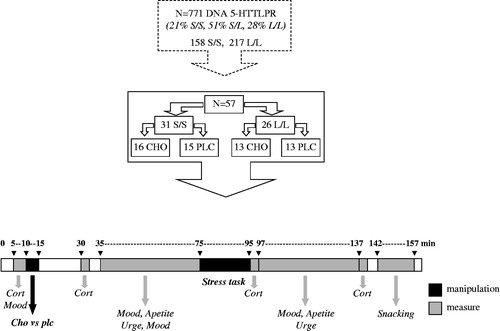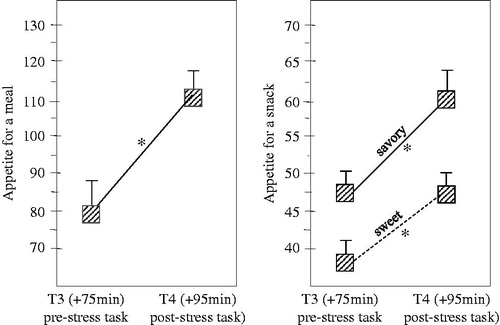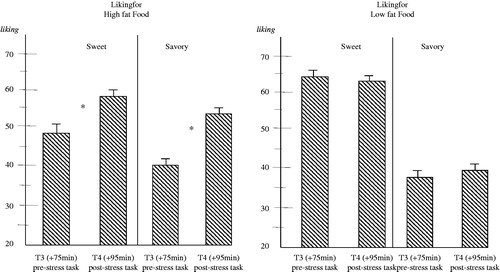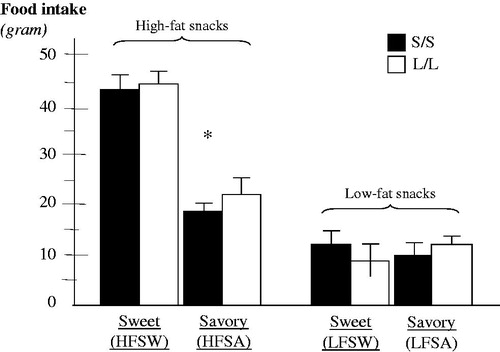Figures & data
Figure 1. Design of the experiment. From a large DNA 5-HTTLPR (5-HT Transporter Linked Polymorphic Region) database S/S (N = 31, 8 males) and L/L (N = 26, 9 males) genotypes were selected and divided into a sucrose-containing (CHO) or placebo (PLC) preload condition. During the acute laboratory stress exposure session, subjects were monitored for changes in salivary cortisol concentration (Cort), mood, appetite and attention for food cues before and after stress, and for snacking after stress, following intake of a sucrose (CHO) containing or placebo (PLC) preload.

Table 1. Total nutrient composition (grams) of the sucrose (CHO) containing and placebo (PLC) preload.
Table 2. Constitution and energy content (per 100 g) of the snacks offered as four different food categories.
Table 3. Demographic and clinical characteristics (mean ± SD) for the 5-HTTLPR genotype participants.
Figure 2. Changes in mood in N = 31 S/S (▪) and N = 26 L/L (□) genotypes across arrival (t1), pre-test (t2), pre stress task exposure (t3) and post stress task exposure (t4). There was a significant increase (*) in post- compared to pre-stress task anger (MANOVA; p < 0.001), tension (MANOVA; p < 0.001) and depression (MANOVA; p < 0.001) regardless of genotype or preload (data pooled across preload conditions).

Figure 3. Acute stress task exposure significantly (*) increased subjective sensation of appetite for a meal (ANOVA; p < 0.001) as well as appetite for a savory (ANOVA; p < 0.001) and sweet snack (ANOVA; p = 0.002) regardless of genotype or preload condition (N = 57; data pooled across genotype and preload conditions). Data are mean ± S.E.M. There was a greater subjective sensation of appetite for a savory snack than for a sweet snack (ANOVA; p = 0.004) regardless of stress task exposure.

Figure 4. Effects for acute stress task exposure on changes in liking for computerized food cues (pictures) were only found to be significant (*) for high fat sweet food cues (MANOVA; p < 0.001) and savory food cues (MANOVA; p < 0.001) but not for low fat food cues (N = 57). Data are mean ± S.E.M. High-fat sweet (HFSW) as well as high-fat savory (HFSA) food pictures increased subjective sensation of appetite for meals and snacks regardless of genotype or preload condition (data pooled for meals and snacks across genotype and preload conditions).

Figure 5. Food intake after completion of the stress task was greater for high-fat snacks than for low-fat snacks (MANOVA; p < 0.001) and only for high-fat snacks there was an increased preference to consuming sweet (HFSW) compared to savory HFSA) snacks (*; ANOVA; p < 0.001). Data are mean ± S.E.M.



